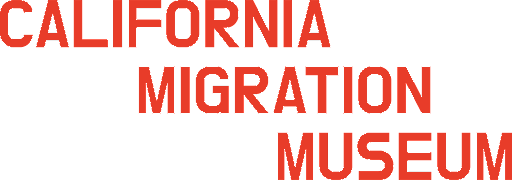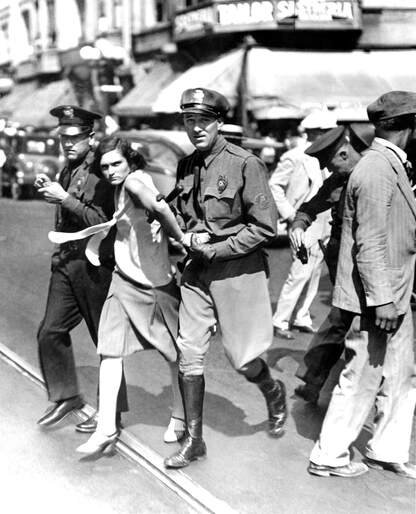The Historic Plaza: A Timeline
The Myth of Beginnings
The starting point of “Ni De Aqui, Ni De Alla,” is a plaque in La Placita Olvera. It honors the 44 Pobladores who established a pueblo there in 1781. They are considered the “founders” of Los Angeles.
In the late 1700s, Franciscan missionaries—working in the name of the Spanish crown—established a network of missions across California to evangelize and “civilize” the indigenous population. But, by 1775, there were major gaps between Spain's settlements across California; 200 miles stretched between Mission San Luis Obispo and Mission San Gabriel. King Carlos III, the ruling Spanish monarch, mandated a secular settlement (pueblo) be established at the confluence of two rivers, in the area now known as Elysian Park.
In 1781, 44 citizens of the Spanish Empire were recruited to settle the pueblo, and make the trek from the Mexican states of Sonora and Sinaloa. The group was multi-racial; according to the Spanish caste system they would have been described as mestizo (Spanish/European and Indigenous American) indio (Indigenous American) and negro (Indigenous African). They established a community and dubbed it El Pueblo de Nuestra Señora la Reina de los Ángeles, or The Town of Our Lady the Queen of the Angels. They built L.A.’s first streets, adobe buildings and the Plaza.
The 44 pobladores are heralded as the founders of Los Angeles, the year 1781 thought of as the beginning of the story. However, when Carlos III designated the settlement, he disregarded the fact there was already a village there—Yanga (or Yangna), the largest Tongva village in the region. In fact, the indigenous Gabrielino-Tongva people had been farming the land in the Los Angeles Basin for thousands of years before the Spanish arrived.
The Tongva lifestyle changed significantly after European arrival. Many were taken into Spanish colonial society through the nearby Mission San Gabriel. Very few survived into the 20th century, dying from smallpox brought by Europeans. Their contribution to the development of early L.A.’s infrastructure and agriculture is often completely erased from the historical record. In November 2023, the park adjacent to the historic plaza, formerly known as Junipero Serra Park, was renamed Yaanga Park.
Los Pobladores monument in the Plaza. The settlers’ mixed-race origins were omitted from the plaque until the 1980s, mirroring a white-washed version of history in which those who arrived in Southern California were presented as Spanish/European-origin. In reality, by the late 1700s, those families' race and ethnic heritage were the result of 400 years of white Spanish colonizers mixing with indigenous peoples of the Americas.
Sonoratown
Just decades after it had won independence from Spain, Mexico ceded nearly half its territory, including Alta California, to the United States under the conditions of the Treaty of Guadalupe Hidalgo in 1848. The state’s wealthy Californio ranchers were soon displaced as Anglo migrants became the majority. Rather than crossing over the border, the border crossed them.
The 1849 Gold Rush brought new waves of Mexicans—miners from Sonora—to northern California in search of gold. However, competition heighted existing-Anglo racism and xenophobia and, by 1850, most Sonorans had been evicted from their mining claims. Many returned to Mexico, but many also lingered in southern California where Latin culture was still predominant. “Sonoratowns” quickly sprang up across the region. In Los Angeles, the erstwhile miners settled in the area north of the city's old plaza, moving into the crumbling old adobes or hastily constructed shacks in their backyards. L.A.’s Sonoratown became a thriving, if impoverished, Mexican community. While life there may not have been comfortable, the residents preserved what was left of the city's Latin culture. But, among white Angelenos, the neighborhood developed a reputation as a rough part of town.
Deteriorating adobe homes in Sonoratown, 1920s. Courtesy UCLA Charles E. Young Research Library Department of Special Collections, A1713
A Growing Metropolis
At the turn of the 20th century, Mexican immigrants started arriving in California in larger numbers, pushed by poverty and violence at home (the Mexican Revolution from 1910 to 1920, followed by the Cristero Wars). In need of cheap agricultural labor, the United States imposed very few restrictions or taxes on Mexican immigration—even after the restrictive 1924 Immigration Act imposed “National Quotas” on Southern and Eastern Europeans.
As Los Angeles boomed, Mexicans were pulled to Los Angeles by plentiful work in factories, agriculture, and construction. Their labor helped build the city from a rural town to a thriving industrial metropolis. By the 1930s, the city was home to more than 200,000 residents of Mexican descent. But they were now subject to increasing xenophobia and viewed as second class citizens. Most immigrants gravitated downtown, settling around La Plaza.
There remained a sense among residents of that neighborhood into the 20th century that the land was once held by a Spanish/Mexican elite. Remnants of place names like the Pico House, named for the last governor of California under Mexican rule, reminded them of a history there that belonged to them. This imagery of a Mexican past helped foster a sense of pride among local Mexican residents of Los Angeles – but it was also an image of the city sold to outsiders.
In the early 1900s, Sonoratown became more and more dilapidated. The Southern Pacific had built its depot and railyard on the neighborhood’s outskirts, making the area valuable for industrial real-estate like warehouses and factories. When Chrisine Sterling stumbled across the Plaza and Olvera Street, most of Sonoratown’s residents had long been pushed out to East Los Angeles. The remaining adobe and brick buildings had fallen into disrepair, and the area was notorious for vice and violence.
A Place of Protest
By the beginning of the 20th century, the Plaza was no longer L.A. 's center of civic life, but a diverse, working class neighborhood and a gateway for newly arrived Mexican, Italian, and Chinese immigrants, who together experienced the growing pains of adjusting to American urban life and industrial labor. Many of these immigrants came to the city with the radical political traditions of their homelands, especially anarchism.
In 1909, L.A.’s city council passed a free speech ordinance in an attempt to fight the growth of the radical labor and socialist movements, particularly the Industrial Workers of the World (IWW). The ordinance prohibited free speech in all but one very strategic location in the city—somewhere far enough from L.A.'s business district but close to the police department and county jails. That place was the Plaza.
The Plaza became a central meeting place for various working-class social and political movements. The Partido Liberal Mexicano, led by the exiled Flores-Magon brothers, Emma Goldman, Socialist mayoral candidate Job Harriman, Upton Sinclair, the I.W.W., Socialists, Communists, Trade Unionists, Japanese workers and Chinese Tongs all found a soapbox and supportive audience in the Plaza. When Christine Sterling proposed a colorful tourist attraction to L.A.’s business leaders and the downtown political establishment, it was perhaps a creative solution to the area’s “nagging problem” of radical political speech…
Today the Plaza is still a central meeting place for activists and Los Angelenos seeking change.
Arrest During a Communist Party Demonstration at La Plaza, September 1, 1930. Courtesy of El Pueblo de Los Angeles Historical Monument Collection
Want to Learn More?
The Los Angeles Plaza: Sacred and Contested Space, by William Estrada
A Brief History of Sonoratown, L.A.'s Lost Barrio
La Plaza: A Center of Injustice and Transformation in Los Angeles. Virtual Exhibit, Museum of Social Justice.



